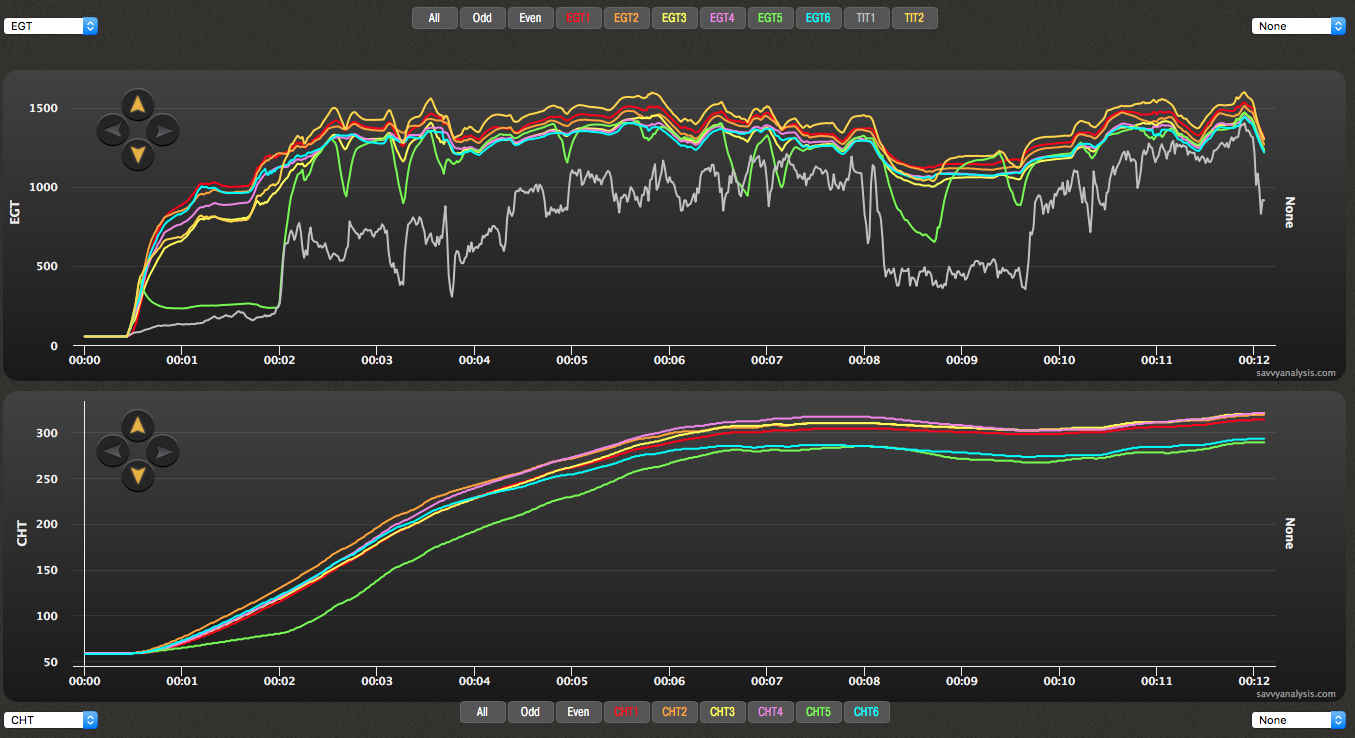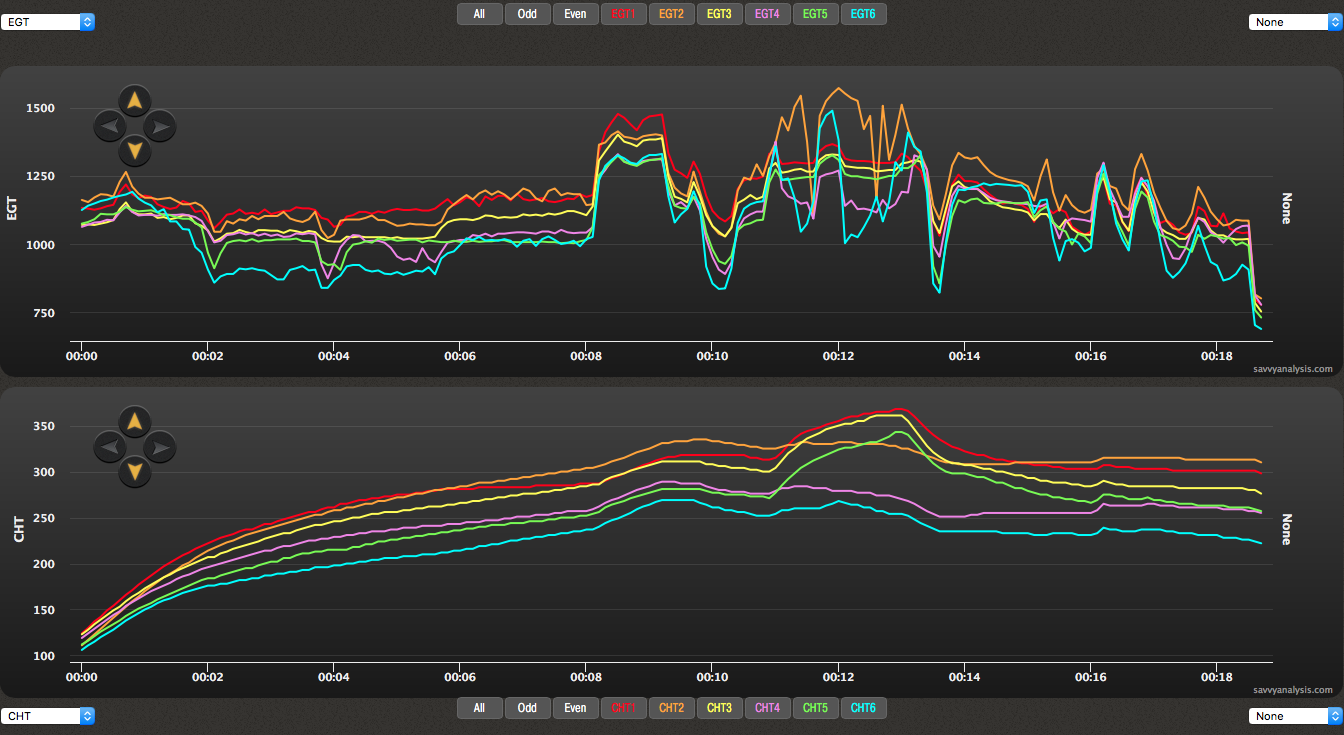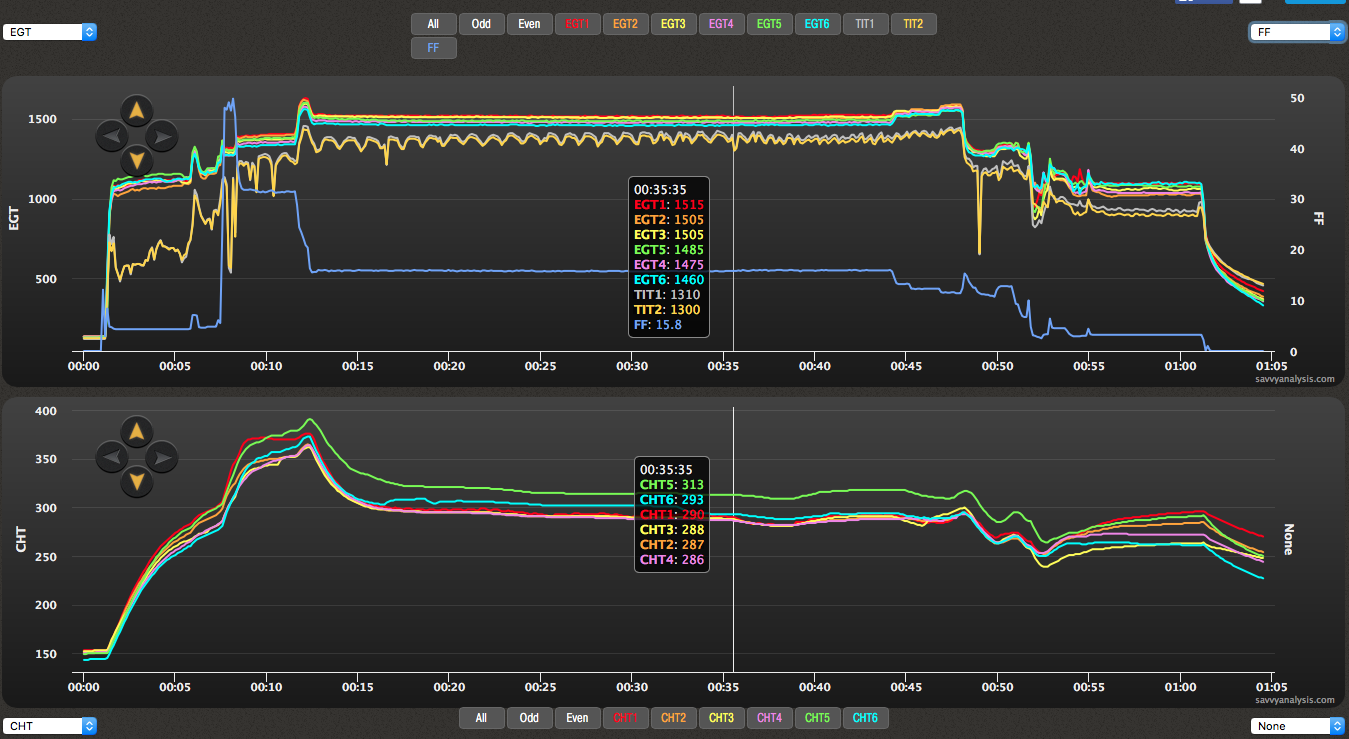Every flight is a series of decisions. Sometimes the decisions are easy — weather’s too bad, pilot’s not feeling good, airplane’s not ready or equipped for the trip. This month’s Puzzler is a series of three flights, each with its own decision tree opportunities.
Let’s warm up with data from a Cirrus SR22 with a Continental/Tornado Alley IO-550-TN.

This post-maintenance flight doesn’t get into the air. The pilot noticed the low TIT and EGT 5, which is corroborated by CHT 5. FF was bouncing up and down, engine was running rough. If we looked at FF and RPM we’d see a couple of runups and mag checks. The data suggests he had decided he wasn’t going up that day, but maybe he could clear the problem – or at least get some data to troubleshoot – at different power settings.
As we go through the analysis decision tree, it seems clear that cyl 5 is the problem, and its irregularity is infecting TIT 1 (the grey trace). TIT 2, on the other hand (the gold trace at the top), seems ok. Is it possible that something is wrong with the turbo on the TIT 1 side and that’s causing the problem with cyl 5? Possible, not likely, because we’d expect cyls 1 and 3 to be erratic, too.
In this case, the evidence arrived the next morning before the analysis was complete. The owner taxied to the shop who had performed the maintenance, and they discovered cyl 5’s injector was loose. Fortunately, it was loose enough to scrub the flight – we don’t want to ponder the outcome of spraying gas on a hot engine. Injector tightened – problem solved.
Next up is data from a Cessna 206 with a Continental IO-520-F.

Let’s start on the left side and work our way across. The changes at the 2, 4 and 6 min marks are responses to power changes during the taxi. Even so, EGTs are a little ragged, with 2 (orange) and 6 (cyan) being worst, and 4 (purple) having an excursion between the 4 and 6 min marks. EGT 5 has an excursion, too. Let’s move right. On the mag check at 8 mins, all are firing, the engine was smooth, and EGTs look ok in the idle that follows. Glancing down, CHTs look normal so far, and and we move to the next limb on the decision tree.
Power comes on at about 11 mins, and it’s a different story. Amid the chaos of EGTs 2, 4 and 6, EGTs 1, 3 and 5 are smooth and normal, like a tornado that takes out one side of a street and leaves the other side intact. Cyls 2, 4 and 6 aren’t making power, corroborated by their CHTs. The decision tree is activated, the pilot enters the downwind, reduces power and lands. Taxiing back, he also tries a couple of power setting changes to troubleshoot.
Puzzle time. First, do we trust the data? Yes, rough running, CHT corroboration – something real happened. Is it a fuel problem or an ignition problem? Cyls 1, 3 and 5 seem ok, so that points away from a mag problem, since on this engine each mag fires plugs from each cylinder. Likewise, if it’s fuel it’s confined to the even side cylinders. Bad plugs in three adjacent cylinders at the same time? Unlikely, but there’s a clue – they’re adjacent – and they share that side’s induction system.
This is a case of an induction clamp coming loose. It was probably loose at engine start, as the excursions of 2, 4, and 6 suggest. But it was keeping up with the flow until the pistons started demanding big air, then it leaked. Clamp tightened, problem solved.
Next up is data from a Lancair IV-P with a Continental TSIO-550.

Contrast the EGTs (so stable and uniform that they form a colorful ribbon of traces at the top) with TIT (the grey and gold traces that are uniform – but not stable). On this one I depicted FF (the blue trace) because with TITs this jumpy we might expect to see jumpy FF. It’s as steady as the EGTs.
CHTs look about as stable as EGTs, except CHT 5 is high throughout. Since EGT 5 is not high – it’s right in the pack – that suggests cooling vs combustion. So we’d recommend checking for a loose baffle or seal. But the issue that prompted analysis was the oscillating TITs. I put the cursor at the point where the waveform for the oscillation changes. It changed a little just before this, but it changes a lot after the cursor. You might think “I don’t have a turbo – this couldn’t happen to me.” Stay tuned.
Let’s puzzle our way through this. Do we trust the data? If the turbine inlet temperature is really oscillating like that, it’s doing so with no corroboration from other data. EGTs, CHTs, FF, RPM – all stable, and no reported vibration in the yoke or other performance anomalies. A pattern like this in EGT is what we look for with our FEVA failing exhaust valve algorithm, and every flight uploaded to SavvyAnalysis is automatically screened for that pattern. That pattern occurs as a hot spot on a valve rotates in service and its proximity to the EGT sensor generates the pattern.
Our analysis could pretty much rule out some horrible ongoing malfunction of both turbos, but finding the solution took investigation with meters and clips. Here’s a clue. There’s something on the airplane that fires periodically, then rests until the next firing – but it’s not a spark plug. Further clue: you probably never see it, but others do.
The power supply for the wingtip strobes on this Lancair was causing interference with the TIT probes, and generating a regular oscillation in the data. But there was nothing special about the TIT probes vs any other probe except the proximity of the cable – it could have corrupted any other important sensor. We don’t know why the pattern changes to the right of the cursor. We do know that once the wiring was adjusted the problem was solved.